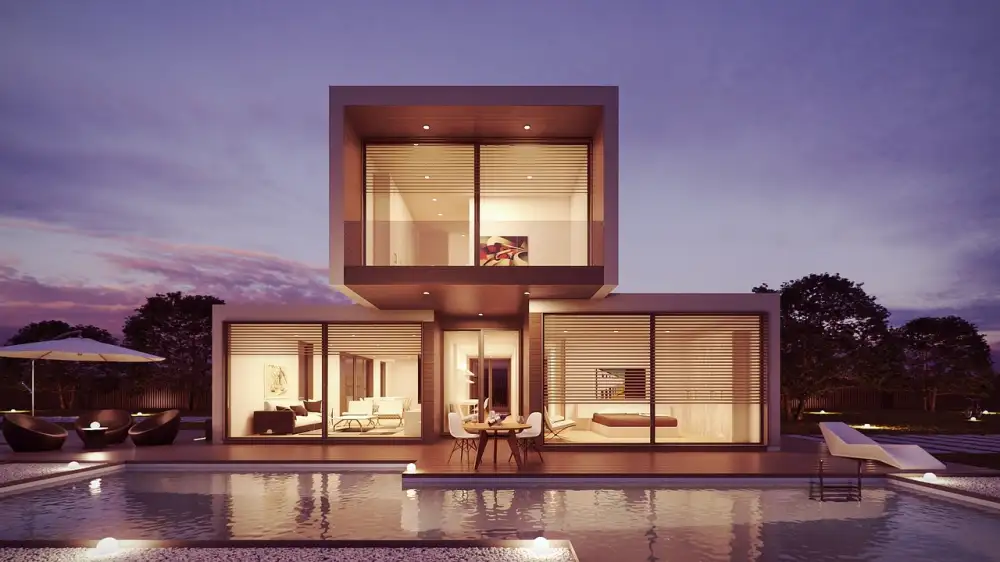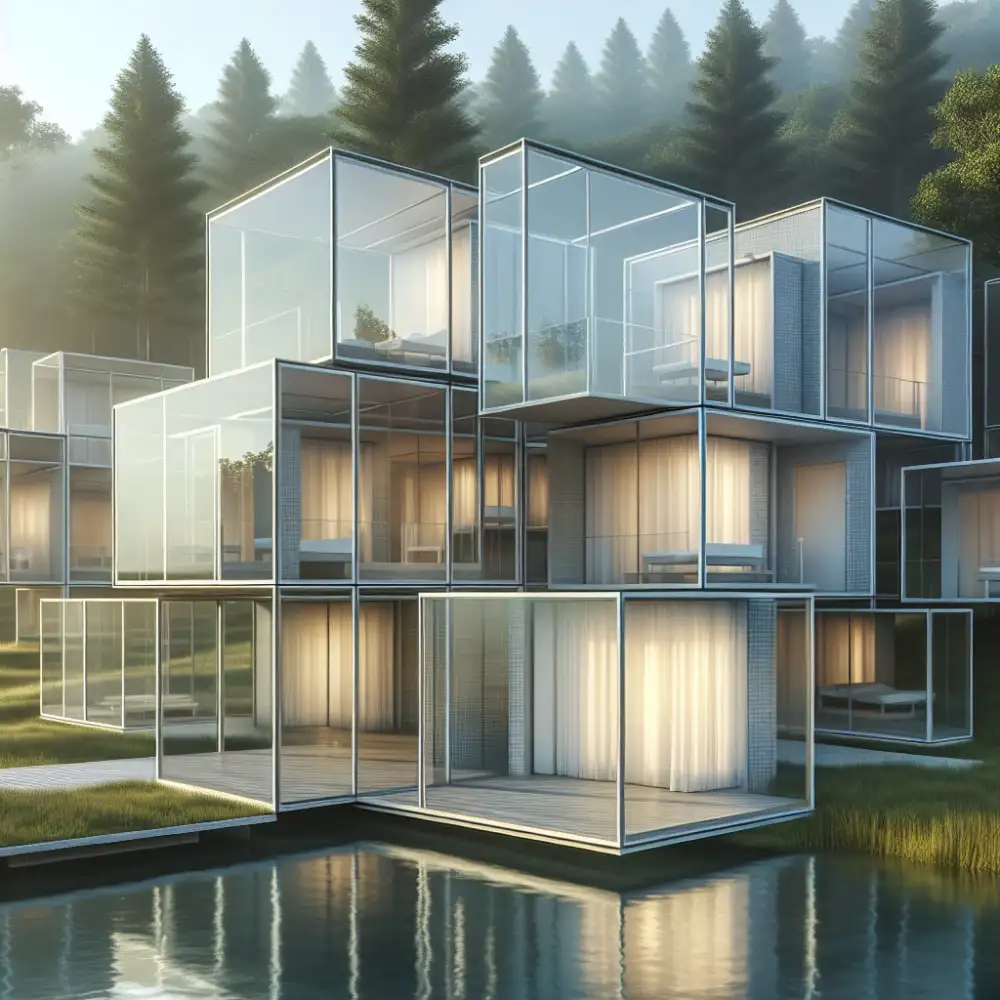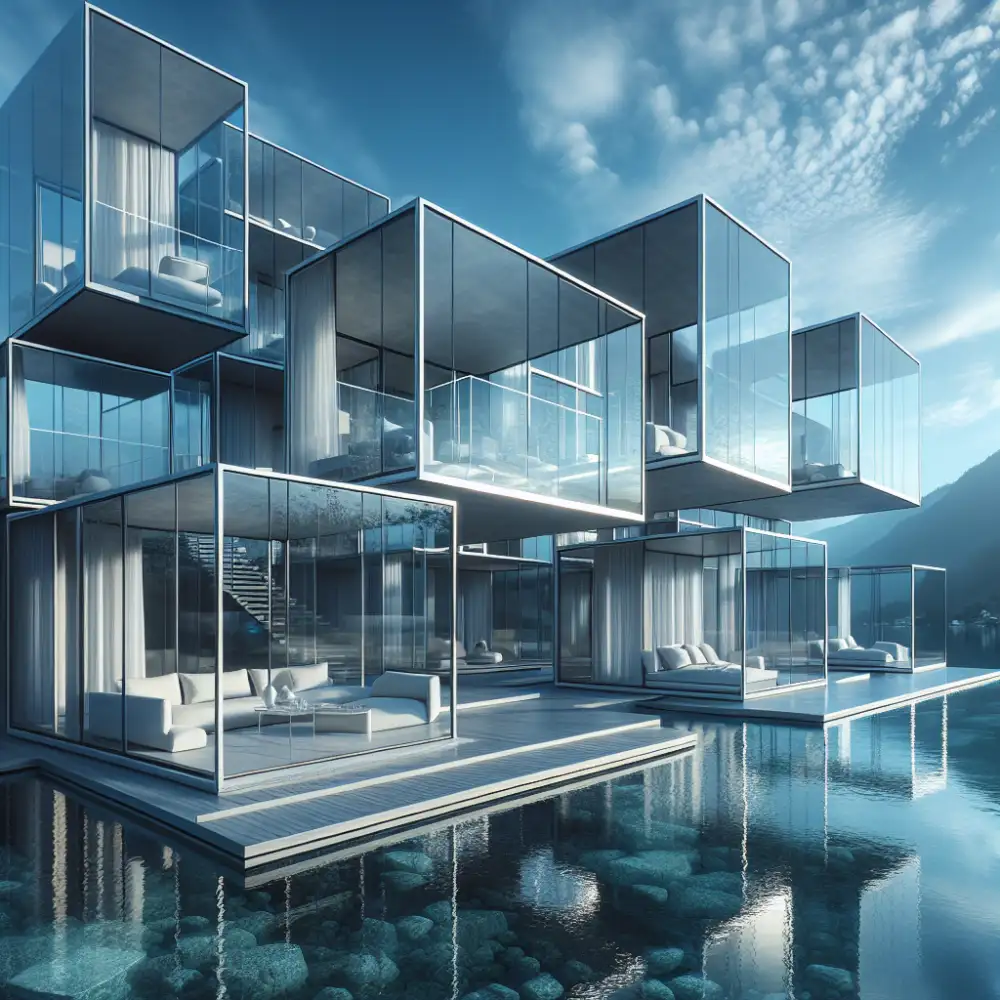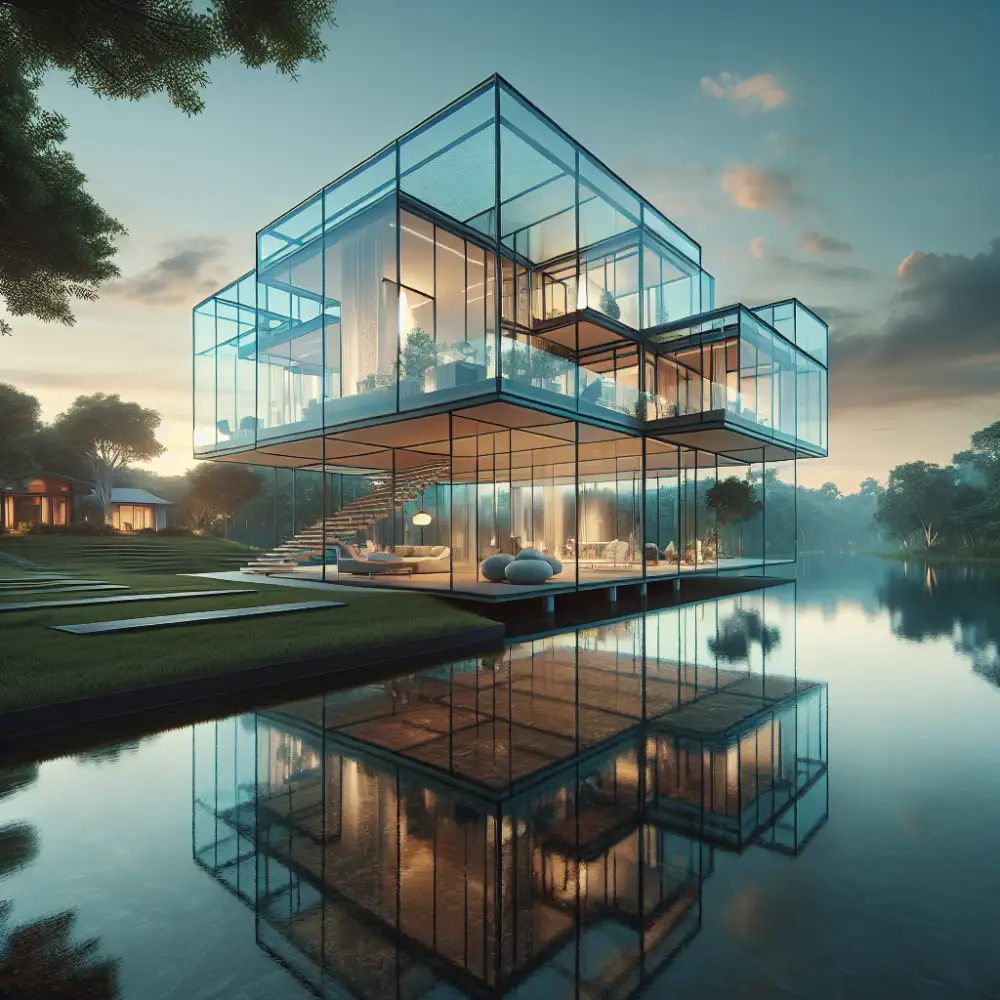See-Through Serenity: Embracing the Future with Glass Modular Homes

Glass modular homes and modular homes made with glass offer a unique opportunity to maximize natural light. Large windows, glass walls, and strategically placed skylights can flood the home with sunlight throughout the day. This abundance of natural light creates a bright and airy atmosphere, making the space feel larger and more inviting.
Beyond aesthetics, natural light offers numerous benefits for homeowners. Studies have shown that exposure to natural light can improve mood, reduce stress, and enhance productivity. It can also help regulate sleep patterns by aligning your circadian rhythm with the natural cycle of day and night.
When designing a glass modular home, consider the orientation of the home to maximize sunlight exposure. South-facing windows will capture the most light during the day, while east-facing windows will provide a beautiful sunrise glow. West-facing windows can be fitted with blinds or shades to control the intensity of the afternoon sun.
Furthermore, incorporating energy-efficient glazing options can enhance the benefits of natural light. Double or triple-paned windows with low-emissivity (low-E) coatings can help insulate the home, reducing the need for artificial heating and cooling. This can lead to significant energy savings and a smaller environmental footprint.
In conclusion, natural light is a valuable asset in any home, and glass modular homes are uniquely positioned to take full advantage of it. By embracing natural light, homeowners can create a brighter, healthier, and more sustainable living environment.
Energy Efficiency
Glass modular homes, known for their modern aesthetics, can also be surprisingly energy efficient. The key lies in utilizing high-performance glazing options and incorporating passive design principles.
Large glass panels maximize natural light, reducing the need for artificial lighting during the day. This significantly cuts down on energy consumption associated with lighting.
Advanced glazing technologies, such as double or triple-paned windows with low-emissivity (low-E) coatings, play a crucial role. These coatings reflect infrared radiation, preventing heat gain in the summer and heat loss in the winter. This helps maintain a comfortable indoor temperature year-round, reducing reliance on heating and cooling systems.
Furthermore, strategically positioning windows and incorporating shading devices like overhangs or awnings can optimize solar heat gain in the winter while minimizing it in the summer. This passive solar design strategy further enhances energy efficiency.
The inherent airtight construction of modular homes, including those with glass elements, also contributes to their energy performance. Tightly sealed building envelopes minimize air leakage, reducing drafts and preventing conditioned air from escaping.

Moreover, many manufacturers of glass modular homes offer energy-efficient appliances and systems as standard or optional features. These can include high-efficiency HVAC units, Energy Star-rated appliances, and LED lighting, further reducing the home's overall energy consumption.
By combining these energy-saving features, glass modular homes can achieve impressive levels of energy efficiency, lowering utility bills and reducing their environmental impact. Homeowners can enjoy the beauty and transparency of glass while minimizing their carbon footprint.
| Feature | Glass Modular Homes | Traditional Homes |
|---|---|---|
| Construction Time | 6-12 months | 12-18 months |
| Energy Efficiency | High (Potential for solar gain) | Moderate |
| Design Flexibility | High | Moderate |
| Privacy | Moderate (Requires window treatments) | High |
Indoor-Outdoor Living
Glass modular homes are blurring the lines between indoors and out. Imagine waking up in your bedroom, sunlight streaming through floor-to-ceiling windows, making you feel like you're waking up in nature. This is the allure of indoor-outdoor living, and modular homes, with their flexible design and construction, are uniquely suited to embrace this trend.
The use of large glass walls, sliding doors, and even retractable glass roofs can seamlessly blend your living spaces with your garden, patio, or surrounding landscape. Imagine hosting a dinner party where guests can easily flow from the dining area to an outdoor lounge, all while enjoying panoramic views.
This connection to nature isn't just aesthetically pleasing; it can have real benefits for your well-being. Studies have shown that exposure to natural light can boost your mood, improve sleep, and even increase productivity. Imagine working from your home office bathed in natural light, feeling more energized and focused.
Furthermore, this style of living encourages a more active lifestyle. With easy access to the outdoors, you're more likely to spend time gardening, exercising, or simply relaxing in the fresh air.
Modular construction enhances these benefits by allowing for customization and strategic placement of glass elements. Want a kitchen that opens up completely to your herb garden? No problem. Dreaming of a bedroom with a private balcony overlooking a wooded area? Modular construction can make it a reality.
However, it's important to consider practical aspects. Proper ventilation is crucial to prevent overheating in sunny climates. Energy-efficient glazing options can help regulate temperature and reduce reliance on artificial heating and cooling.

Ultimately, embracing indoor-outdoor living in a glass modular home is about creating a harmonious connection between your living space and the natural world, enhancing your well-being and creating a truly unique and inspiring place to call home.
Customization Options
You have complete control over the layout and size of your home. Add, remove, or resize modules to create a floor plan that fits your lifestyle and land.
Exterior Finishes
Choose the degree of transparency with options like floor-to-ceiling glass or frosted sections.
- Tinted glass controls sunlight and improves energy efficiency.
- Select from various framing materials like steel, wood, or composite materials.
Interior Design
Customize your interior with various flooring options, wall finishes, and fixtures.
Sustainability Features
Incorporate eco-friendly features like solar panels, green roofs, and rainwater harvesting systems.
With endless customization possibilities, your glass modular home will be a unique expression of your style and a model of sustainable living.
Sustainability Considerations
Glass modular homes, while architecturally striking, raise important sustainability considerations throughout their lifecycle:
- Material Production: Glass production is energy-intensive, requiring high temperatures and generating significant emissions. Sourcing recycled glass and using energy-efficient manufacturing processes can mitigate this impact.
- Transportation: The weight and fragility of glass modules can lead to increased transportation costs and emissions compared to lighter materials. Optimizing transportation logistics and sourcing glass locally can help.
- Construction: Modular construction, in general, tends to be more efficient and generate less waste than traditional methods. However, the specialized nature of glass modules may require skilled labor and specific equipment.
- Energy Efficiency: Glass homes can suffer from significant heat gain and loss due to the high thermal conductivity of glass. Utilizing high-performance glazing, such as low-e coatings and insulated glass units, is crucial to maintain a comfortable indoor temperature and reduce reliance on heating and cooling systems.
- Water Use: While glass itself doesn't consume water, the manufacturing process and potential landscaping choices around a glass home can impact water usage. Implementing water-efficient fixtures and considering drought-tolerant landscaping can minimize water consumption.
- End-of-Life: The longevity and recyclability of glass are positive aspects. However, the deconstruction and separation of different materials in glass modules require careful planning to ensure proper recycling and minimize waste.
Choosing sustainable materials for the framing and insulation of glass modular homes is crucial. Opting for sustainably harvested timber, recycled steel, or other eco-friendly alternatives can significantly reduce the environmental footprint.

Ultimately, the sustainability of a glass modular home hinges on a holistic approach that considers material sourcing, manufacturing processes, transportation, construction practices, energy efficiency, water use, and end-of-life management. By carefully addressing these factors, glass modular homes can aspire to achieve both aesthetic appeal and environmental responsibility.
Cost and Maintenance
Glass modular homes, while architecturally stunning, often come with a higher price tag than their traditional counterparts. The extensive use of high-grade glass, specialized framing systems, and often complex installation processes contribute to the elevated cost. Furthermore, the unique design may necessitate custom fabrication for certain modules, adding to the overall expenses.
Maintenance for glass modular homes presents its own set of considerations. While modern glass is durable and treated for longevity, keeping those expansive surfaces clean and streak-free can be a demanding task. Specialized cleaning solutions and equipment might be necessary, adding to the maintenance costs. Additionally, the thermal performance of glass, while improving with technology, requires attention. Heating and cooling costs might be higher compared to traditionally built homes, depending on the climate and the efficiency of the glass and insulation used. Regular inspections for leaks or potential seal failures are essential to prevent water damage and maintain the structural integrity of the home.
Published: 20. 06. 2024
Category: Food



